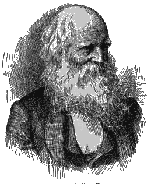|
1794–1878,
American poet and newspaper editor, born in Cummington, Mass. The son of
a learned and highly respected physician, Bryant was exposed to English
poetry in his father’s vast library. As a boy he became devoted to the
New England countryside and was a keen observer of nature.
In his early poems such as “Thanatopsis,” “To a
Waterfowl,” “Inscription for the Entrance to a Wood,” and “The Yellow
Violet,” all written before he was 21, he celebrated the majesty of
nature in a style that was influenced by the English romantics but also
reflected a personal simplicity and dignity. Admitted to the bar in 1815
after a year at Williams and private study, Bryant practiced law in
Great Barrington, Mass., until 1825, when he went to New York City. By
that time he was already known as a poet and critic.
|
He became
associate editor of the New York Evening Post in 1826, and from
1829 to his death he was part owner and editor in chief. An industrious
and forthright editor of a highly literate paper, he was a defender of
human rights and an advocate of free trade, abolition of slavery, and
other reforms. He also holds an important place in literature as the
earliest American theorist of poetry. In his Lectures on Poetry
(delivered 1825; published 1884) and other critical essays he stressed
the values of simplicity, original imagination, and morality.
During his later career Bryant traveled widely, made many
public speeches, and continued to write a few poems (e.g., “The Death of
the Flowers,” “To the Fringed Gentian,” and “The Battle-Field”). His
blank verse translation of the Iliad appeared in 1870, that of the
Odyssey in 1872.
See biographies by P. Godwin (2 vol., 1883; repr. 1967),
J. Bigelow (1890, repr. 1970), H. H. Peckham (1950, repr. 1971), and C.
H. Brown (1971). |

